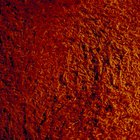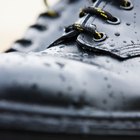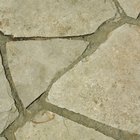Road salt keeps your feet firmly planted on the ground when you're trudging through winter's snow and ice, but it can also leave unsightly stains on your shoes. Exposing your leather, suede and even rubber boots and shoes to salt can result in white lines and rings on your shoes. Promptly removing the salt is the key to restoring your shoes to their pre-winter look.
Leather
Salt can ruin a pair of leather boots or shoes, so you'll need to quickly remove the salt residue and any already-developed stains from them. Once you've found a spot away from the salty sidewalks -- preferably one with a roaring fire -- tend to your leather shoes with a simple mixture.
Combine white vinegar and water, beginning with about a tablespoon of vinegar in a quart of water. Add more vinegar a tablespoon at a time as needed to strengthen the stain-fighting solution.
Dip a clean, soft cloth into the mixture, and gently massage this eco-friendly cleaning solution into the salt stains. Once you've removed the stains, wipe a clean, dry cloth over the leather to remove any of the cleaning solution. Repeat the process as frequently as needed to fully remove the salt stains.
Suede
Suede and salt don't exactly mix, but that doesn't mean your suede shoes or boots are irreparable after an encounter with road salt. White vinegar is also an effective stain-removal treatment for suede. However, a few extra tools can help you revitalize your stained suede.
A suede brush features soft bristles and a durable design, and you can use it to easily brush away minor salt stains. Just apply a dab of the vinegar-water solution to the stain, and use the suede brush to eliminate the stain.
Suede erasers look a lot like the erasers you used in elementary school. However, these erasers, which are made of art gum, can target tough stains, including salt stains, on this delicate leather.
Combine these two tools to eliminate salt stains for good. First, use the suede brush to knock any salt off of the boot or shoe. Then, use the eraser to target any lingering salt stains.
Rubber
Rubber is the most durable shoe in the winter, so those winterized rubber shoes and boots will be least likely to be affected by salt. However, an occasional stain may pop up, especially on black boots, which fail to mask white salt stains. When it does, using a dish soap and water solution will quickly eliminate it. Since your rubber winter kicks are waterproof, you can simply rinse away the stains with soapy water and let them dry in preparation for your next snowy adventure.
Protection and Prevention
Weatherproofing your winter boots and shoes can protect them from future salt stains. How to protect your shoes depends on the material.
- Leather: Work a leather conditioner into your boots or shoes after you eliminate the salt stains. Then, grab a waterproofing spray to make sure those salt stains can't penetrate the leather next time around.
- Suede: These waterproofing sprays are also an effective protectant for suede boots and shoes. Look for a spray that's designed especially for suede -- rather than all leathers in general -- to maximize protection.
- Rubber: While rubber is naturally resistant to water, rubber conditioners can target blooming marks, which can occur during winter's chill and resemble salt stains.
Related Articles

Does Salt Ruin Shoes?

How to Clean Salt Stains From Suede

How to Clean Nylon Totes Boots

How to Get the White Out of Leather ...

How to Revitalize Leather Shoes

How to Get Sneakers to Stop Smelling

How to Shine Patent Leather Shoes

How to Preserve Leather Boots

How to Clean Sperry Shoes With a Stain

How to Clean Scuff Marks Off of Tan ...

How to Clean Diesel Shoes

How to Break in Boots Fast

How to Remove Scuffs From Soccer Cleats

Does Salt Ruin Slate Walkways?

How to Clean Scuffed Up Rain Boots

How to Clean the Insides of Rubber Boots

How to Clean Keen Shoes

How to Clean Suede Boots at Home

How to Get Scuffs Off Vinyl Shoes

How to Take Care of a Hush Puppies Shoe
References
Writer Bio
Barbie Carpenter worked as a technical writer and editor in the defense industry for six years. She also served as a newspaper feature page editor and nationally syndicated columnist for the Hearst Corp. Carpenter holds a Bachelor of Science in journalism from the University of Florida and a graduate certificate in professional writing from the University of Central Florida.